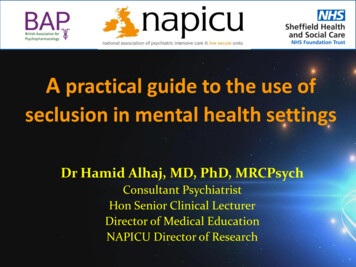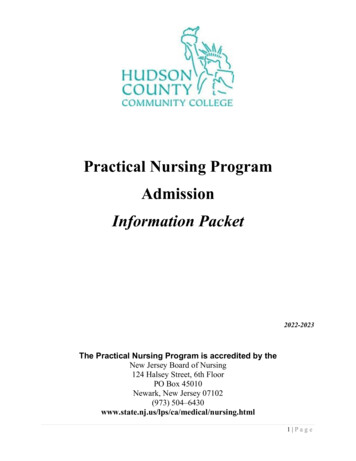
Transcription
A practical guide to the use ofseclusion in mental health settingsDr Hamid Alhaj, MD, PhD, MRCPsychConsultant PsychiatristHon Senior Clinical LecturerDirector of Medical EducationNAPICU Director of Research
Objectives To understand what seclusion is and how it isviewed compared to other restrictiveinterventions. To develop your knowledge of what the cautions ofseclusion are and when it is consideredappropriate to use. To recognise the standard requirement forseclusion environments/ facilities.
Background Definition (the Code of Practice to the MHA 1983 in England) “the supervised confinement of a (person) alone ina room, which may be locked, for the protection ofothers from significant harm. Its sole aim is to contain severely disturbedbehaviour, which is likely to cause harm to others”.
Restrictive interventions RIs include Mechanical Physical restraint Chemical Seclusion Controversies around Legal Ethical Practical Risks
Seclusion5Use of seclusion 2016/17(1 outlier removed) The national meanaverage shown is 203incidences per 100,000bed days (excludingleave).SHSC reports 3rd highestin the country, with afigure of 614 incidencesper 100,000 occupied beddays.Over the 3 year periodincident numbers havereduced slightly (5%) to299 for 2016-17.Compared against beddays Sheffield incidentrates for seclusion are35% higher over the 3year period.Rates in Sheffield havebeen between 2 to 3times higher than the NHSaverage over the 3 yrs.Data: 12 mths worth.2014-152015-162016-17No of seclusion incidents315296299Sheffield per 100,000 bed days453507614UK per 100,000 bed days156219203UpdateApr-Dec17221 sameas2016-172016
Cautions with seclusion? The use of seclusion can have a detrimental psychological, emotionaland physical effects on patients (Bonner et al 2002; Holmes et al 2004). RIs have been implicated in being: ‘a major contribution to delayingrecovery, and have been linked with causing serious trauma, bothphysical and psychological’ (Department of Health, 2014). However, a study found that the presence of seclusion did not appear toaffect the rate of recovery as measured by HoNOS (Griffiths et al 2018). A US study (Frueh et al 2005) found traumatic and harmfulexperiences within psychiatric settings, with seclusion being used at59 % and restraint 34 % of inpatinets. Seclusion should only be used for detained patients (CoP).
Does seclusion work? Systematic reviews have found no randomised controltrials to assess its effectiveness and safety (Nelstrop et al 2006;Sailas & Fenton 2000; Van Der Merwe, Bowers, et al 2009). an RCT involving restraint or seclusion may beunethical. Sailas and Fenton (2000) suggested that RIs are of notherapeutic benefit.
Does seclusion have therapeuticbenefits? There are particular situations, where all other optionshave been considered, seclusion may be the optionthat presents the lowest risk and is likely to be of mostbenefit to the individual concerned, i.e. ‘leastrestrictive’ option (CoP). Seclusion room can provide a unique low stimulusenvironment. Some patients prefer it to other RIs. Rate of improvement (using HoNOS) was higher in thesecluded group with borderline PD (Griffiths et al 2018).
Factors associated with seclusion Generally inconsistent findings among different studies. Demographic: younger age, being male, longer hospitalstay and involuntary admission. Diagnosis: schizophrenia, bipolar, personality disorders,organic and substance use related disorders. Clinical settings: The Royal College of Psychiatrists(2007) reported that seclusion is more frequent in forensicunits (53%) compared to acute and rehabilitation wards(33 and 25%, respectively).
Seclusion rooms Privacy and dignity. Physical comfort. Access to food and drink. Communication with staff.
Seclusion rooms (MHA CoP) specifically designed and designated for the purpose ofseclusion. allow for communication with the patient (e.g. via anintercom). include limited furnishings (a bed, pillow, mattress and safeblanket or covering). have no safety hazards. have robust, reinforced window(s) that provide natural light have externally controlled lighting.
Seclusion rooms (MHA CoP) have robust door(s) which open outwards. have externally controlled heating and/or air conditioning,which enable those observing the patient to monitor theroom temperature. have no blind spots, and alternate viewing panels or CCTVshould be available when required. have a clock that is always visible to the patient from theroom. have access to toilet and washing facilities.
New Seclusion Design – Media wall https://www.youtube.com/watch?v bUrnTNJ9uME
Conclusions Seclusion is of questionable therapeutic benefit andshould not be used unless the risks cannot bemanaged by any less restrictive approach. Seclusion must only be used in the context of acomprehensive policy on the management andprevention of aggressive behaviour. Proactive behavioural support plans can mitigateagainst the need for such restrictive measures. It is necessary to acknowledge the use of seclusionand ensure that it is properly monitored with theaim of reducing the known risks associated with itsuse.
Thank You
The use of seclusion can have a detrimental psychological, emotional and physical effects on patients (Bonner et al 2002; Holmes et al 2004). RIs have been implicated in being: îa major contribution to delaying recovery, and have been linked with causing serious trauma, both











